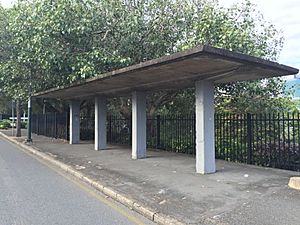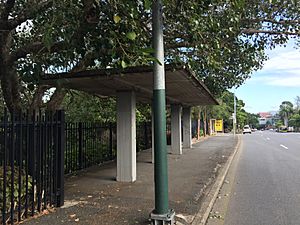Albert Park (North) Air Raid Shelter facts for kids
Quick facts for kids Albert Park (North) Air Raid Shelter |
|
|---|---|

Albert Park (North) Air Raid Shelter
|
|
| Location | Albert Park, Wickham Terrace, Spring Hill, City of Brisbane, Queensland, Australia |
| Design period | 1939 - 1945 (World War II) |
| Built | c. 1942 |
| Architect | Frank Gibson Costello |
| Official name: Albert Park (North) air raid shelter | |
| Type | state heritage (built) |
| Designated | 31 May 2005 |
| Reference no. | 602473 |
| Significant period | 1942 (fabric) 1940s (historical) |
| Builders | Brisbane City Council |
| Lua error in Module:Location_map at line 420: attempt to index field 'wikibase' (a nil value). | |
The Albert Park (North) air raid shelter is a special building in Albert Park, Spring Hill, Brisbane, Australia. It was built around 1942 during World War II to protect people from air raids. This shelter was designed by Frank Gibson Costello and built by the Brisbane City Council. Today, it is listed on the Queensland Heritage Register because of its historical importance.
Contents
Why Air Raid Shelters Were Built
World War II and Australia's Role
World War II was a huge global conflict. On December 7, 1941, the United States joined the war. This happened after Japan attacked the American fleet at Pearl Harbor in Hawaii. Soon after, Japan bombed Darwin, Australia, in February 1942. Many Australian soldiers were also captured when Singapore fell.
Australia quickly prepared to defend itself from a possible Japanese invasion. Queensland became a key support base for the war in the Pacific. Many Australian and American soldiers came to Queensland. The population of Brisbane grew a lot.
Brisbane's Importance During the War
Brisbane was Queensland's largest city and a major northern hub in Australia. Important military headquarters were set up there. General Douglas MacArthur, a top Allied commander, was based in Brisbane. General Sir Thomas Blamey, Australia's commander, also used buildings in Brisbane. Because of its importance, Brisbane was a likely target for bombing. Quick action was needed to protect people from air raids.
Protecting the City: Air Raid Precautions
The Brisbane City Council was in charge of Air Raid Precautions (ARP). This meant setting up systems to warn people and protect them. They created an Air Raid Warden system and firefighting plans. They also built many air raid shelters. Large saltwater pipes were even laid along city streets to help fight fires.
On Christmas Eve, 1941, all Australian states were told to start building shelters. People dug trenches in parks and schoolyards. Windows were taped to prevent glass from shattering. Buildings also had "brownouts," meaning lights were dimmed to make them less visible from the air.
Building Shelters for Everyone
Public Shelters in Brisbane
The government ordered the Brisbane City Council to build 200 public shelters. Work began quickly in December 1941. Later, 75 more shelters were ordered. In the end, 235 air raid shelters were built. Most were finished by June 1942.
The Council also built about three kilometers of covered trenches in public parks. For example, there were 315 meters of concrete-pipe trenches in the City Botanic Gardens. These trenches could hold many people.
Shelters Across Queensland
Other towns along Queensland's coast also had to build shelters. These shelters had to follow a special Air Raid Shelter Code. Many towns built surface shelters or trenches for their communities. This effort cost a lot of money.
Some towns had problems building enough shelters. In those cases, the Department of Public Works helped. However, they sometimes had trouble getting towns to pay their share.
Smart Design for the Future
Reusable Shelter Designs
Of the 235 public shelters built in Brisbane, 21 still exist today. Most of these are owned by the Brisbane City Council. Many were designed to be "reusable" after the war.
Frank Gibson Costello was the Brisbane City Council's City Architect from 1941 to 1952. He designed these special shelters. He wanted them to have a purpose even after the war ended. He said that if the shelters weren't needed for air raids, they could become a "nuisance." So, he planned them to fit into city improvement projects after the war.
Modern Architecture and Camouflage
Costello's designs were inspired by a modern style of architecture. This style used new materials and focused on how buildings would be used. It often featured flat roofs and simple shapes. Even though the shelters were small, their design showed this modern style.
Many of these reusable shelters were built under large fig trees. This helped to camouflage them from enemy planes.
Different Types of Reusable Shelters
Costello designed a few types of reusable shelters:
- "Park" type shelters: These had four central pillars supporting the roof. Their outer walls could be removed after the war. This would turn them into open shelters for parks. Many of these were built, and 17 still survive today. Two of them are in Albert Park.
- "Bus" type shelters: These were designed so that three brick walls could be removed. This would leave a concrete back wall and pillars at the front. Only two of these types still exist.
- "Bus (stone)" type shelters: Similar to the "bus" type, but with a stone back wall and stone pillars. Only one of these remains.
What Happened After the War
Most of the buildings made for the war in Brisbane were removed. Saltwater pipes, trenches, and sirens disappeared. Many standard air raid shelters that stood in the middle of streets were also taken down.
However, 20 of Costello's 58 reusable public shelters survived. Their blast walls were removed, just as he planned. This gave them a new purpose. The Albert Park (North) air raid shelter had its blast walls removed after World War II. Its floor is now covered with bitumen, forming part of the footpath.
What the Shelter Looks Like Now
The Albert Park (North) air raid shelter is a rectangular concrete building. It has a strong floor, which is now covered with bitumen. A flat roof is held up by concrete pillars. You can still see the original floor under the bitumen. The shelter is unpainted. You can even see some metal rods sticking out from where the walls were quickly removed. It stands on the footpath at the northeast corner of Albert Park. Large trees hang over it, providing shade.
Why It's a Heritage Site
The Albert Park (North) air raid shelter was added to the Queensland Heritage Register on May 31, 2005. This means it's a very important historical place.
Showing Queensland's History
This shelter helps us understand how Queensland changed during World War II. It shows how people in Brisbane prepared for air raids. It reminds us of the war's impact on everyday life.
A Rare Survivor
Many air raid shelters were built during World War II. But only a few of them still exist today. This makes the Albert Park shelter quite rare. It's also one of the few wartime structures built by the Brisbane City Council that survived.
A Great Example of Its Kind
The shelter's strong build, rectangular shape, and location near a busy area show what a public air raid shelter in Brisbane looked like during World War II.
Creative Design and Technology
The Albert Park (North) air raid shelter is now used as a shade shelter. This shows how clever its original design was. It was made to have a second use after the war. It's a lasting example of creative design and the use of concrete during World War II.
Connected to Important People
This air raid shelter is important because it shows the work of the City Architect's Office during the war. It especially highlights the designs of City Architect F.G. Costello.


